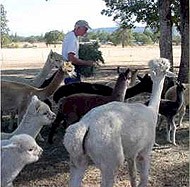|
Featured
Article
Alpaca-Ranching Essentials
Contributed
by Alpacas
at Lone Ranch
 A
few Alpaca facts: A
few Alpaca facts:
-
Alpacas are earth friendly, they browse
on natural grasses without harming trees or
terrain.
- Alpacas
are safe, easy to handle, they do not butt
or bite.
- Alpacas
are easy to raise, requiring minimal feed,
shelter, fencing, or veterinary care.
- Alpacas
are not killed, instead they produce a renewable
cash crop in the form of fiber.
- Alpacas
are fully insurable against loss and come
with reproductive guarantees.
- Alpacas
have tax advantages such
as expense deduction, depreciation, and the
deferred recognition of accumulating wealth.
- Lifespan:
15 to 20 years.
- Average
height: 36" at the withers.
- Average
weight:
15 to 19 pounds at birth, they grow to 100 to
175 pounds, less than 1/2 the weight of a Llama.
- Average
Gestation: 335 - 350 days and virtually
never twins.
- Birth:
Babies usually try to stand within 30 minutes
and nurse within 1-2 hours. Birth almost always
occurs between 9am and 2pm allowing you to sleep
comfortably through the night.
-
Breeding: Alpacas do not come into heat,
allowing ranchers easy control of the birthing
season and planning for extended vacations.
- Colors:
Alpacas come in many colors, more than 22 natural
variations and blends.
Alpacas
were a cherished treasure of the ancient Inca
civilization. They played a central part in the
Incan culture that was located on the high Andean
plateau and mountains of South America. Alpacas,
and their cousins, the Llama, have been domesticated
for some 6,000 years.
Some
alpacas can be purchased as pets for as little
as $600 each. But many people like to breed and
ranch alpacas:
 A
Typical Alpaca-Ranching Investment A
Typical Alpaca-Ranching Investment
There
are many financial scenarios for beginning alpaca-ranching.
However the one described here would not be unusual.
Initial Cost - $25-$35,000 * * does not
include land, fencing, facilities etc.
Includes:
-
Bred (pregnant) female
- Young
Yearling female
- Adult
intact male
- Gelded
male
- FREE
set up of animal and business operations
Estimated Income - $10-$12,000/year *
* assumes average sale prices and typical expenses
at $200-$400 per alpaca/yr
- Young
females - $8-$12,000
- Young
males - $2-$5,000
Estimated Tax Benefits - $25-$30,000 plus
*
* all expenses are deductible, all development
costs are depreciated
- Year
I - expenses + $20,000 depreciation.
- Year
II - expenses + $5-$10,000 depreciation.
- Year
III and on - expenses + remaining depreciable
costs e.g. alpacas, home office, truck, barn,
fence, computer, camera, etc.
Key Ingredients For Success - We have been
very successful as a medium-sized ranch, however
some others have not. Discussions with many newcomers
indicate the following as important ingredients
for fiscal success.
- Love
of the animals such that routine care is smoothly
done by the owners without employees.
- Acknowledging
the business aspect of alpaca-ranching and following
a simple marketing and sales plan.
- Being
in a financial position to take full advantage
of the many tax benefits.
- Luck
- the birth of females facilitates sales and
herd growth. While the odds are 50/50 for males
to females, at times one or the other can seem
to predominate and thus slow or speed the process.
For each of the last several years we have legitimately
paid many thousands of dollars less in taxes
than if we were not in the business of alpaca
ranching. Advice on taxes came from The Farmers
Tax Guide, a publication obtained directly from
the IRS and our tax consultant.
While
we cannot offer you tax advice, we can share our
experiences with you:
The
IRS allows deduction of 100% of direct expense
from our taxes. Major expense items for
deduction are:
- Feed
-
about 25 cents/animal per day.
- Veterinary
- about $25/animal annually. We have kept our
expense down by learning to give our own medications
and vaccinations.
- Travel
-
all of our local and distant business related
travel.
- Maintenance
and repair - to all business related structures
and equipment.
- Services
-
accounting, tax, legal, education, and advertising.
- And,
the portion of our home expenses that
are allocated to our at-home office, i.e. phones,
utilities, insurance, and maintenance.
In addition the IRS allows us to depreciate tangible
personal property off our taxes. Major items for
depreciation are:
- Alpacas
- 100% of the cost of the alpacas depreciated
over 5 years.
- Vehicles
and equipment including computers, cameras,
fax and cell phones.
- Facilities
- the outbuildings used for storage, feeding
and sheltering alpacas.
- Fencing
- of our properties and pastures.
- And,
a portion of the cost of construction and use
of our home as an at-home office.
- Also,
Section 179 of The Farmers Tax Guide
allows us to accelerate depreciation of $20,000
of our startup costs into one year. Section
179 has resulted in a marked reduction in the
taxes that we have ultimately paid each year.
Perhaps
the biggest advantage of all has been our ability
to build net worth on a tax-deferred basis. We
are allowing a portion of our herd to multiply
and grow over time without paying taxes on the
increased size and value until the alpacas are
sold.
© Copyright 2005 Alpacas
at Lone Ranch. No unauthorized duplication
without written consent.
|


![]()

